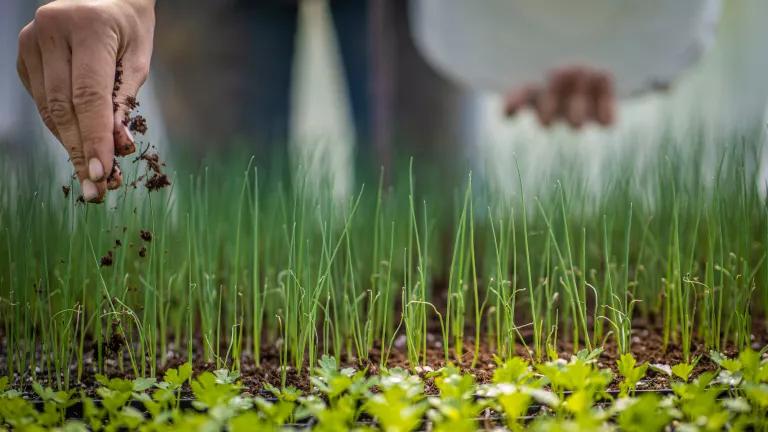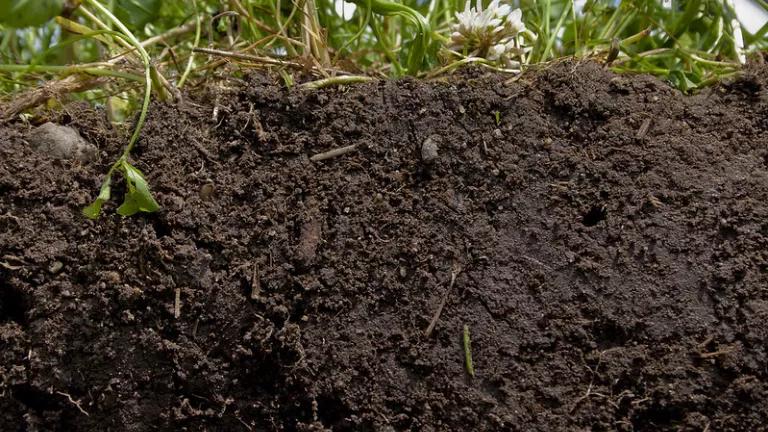Good News for Cover Crops
Less than 7 percent of U.S. cropland uses cover crops—meaning there’s a huge opportunity to scale up a practice that’s good for farmers and good for the environment.

A farmer examines a field cover cropped with cereal rye in Nebraska
Cover crops are one of the most effective farming tools we have available for building soil health, fighting climate change, and improving water quality. Yet less than 7 percent of U.S. cropland uses cover crops—meaning there’s a huge opportunity to scale up a practice that’s good for farmers and good for the environment. Thankfully, progress is being made. Here are three big things happening on the cover crop front, and why they matter:
1. USDA announces national crop insurance incentive for cover crops
As part of USDA’s Pandemic Assistance for Producers initiative, the Risk Management Agency (RMA) is offering farmers who planted cover crops during the 2021 cropping year $5 per acre of premium support on their crop insurance. This is wonderful news, for farmers and the environment.
According to USDA surveys, crop insurance incentives may be one effective policy tool for persuading more farmers to plant cover crops on more acres. Crop insurance is a widely used federal program; in the Midwest, total cropland acres enrolled in crop insurance exceeds 80% in most states. As climate change exacerbates the weather conditions that prompt insurance claims, the program will only become more expensive to taxpayers over time. That’s why it is essential to leaven the use of crop insurance with incentives for climate-friendly practices that should make farms more resilient while reducing overall program costs.
2. Illinois doubles its budget for Fall Covers for Spring Savings program
This federal program is an innovative initiative modeled off one in Iowa that offers farmers who plant cover crops a $5 per acre savings on their crop insurance in the following year after they plant cover crops. Illinois was the first state to follow in Iowa’s footsteps with the Fall Covers for Spring Savings Program and just this past weekend, the Illinois legislature passed a budget that doubles funding for the program. Past demand for the popular program in Illinois exceeded the level of funding by more than double, so the increase will be welcome relief to Illinois farmers. According to an op-ed by Kris Reynolds from American Farmland Trust, who advocated for the funding increase:
“The Illinois Nutrient Loss Reduction Strategy estimates that planting cover crops can reduce nutrient losses from croplands by at least 30 percent, which would go a long way to preventing toxic algae blooms in local lakes and the Gulf of Mexico.”
3. Is Wisconsin Next?
Meanwhile, in Wisconsin, supporters are advocating for the state to fund its own program modeled off the program in Iowa and Illinois. According to an op-ed by Margaret Krome from Michael Fields Agricultural Institute, a 2019 survey found that two-thirds of farmers who had not previously planted cover crops would consider doing so with a crop-insurance incentive program, and two-thirds of those who had planted cover crops would think about planting more. If the program is included in Wisconsin’s budget this year, then Wisconsin farmers could factor the incentive into their planning for cover crops by the fall.
Looking ahead
USDA’s Pandemic Cover Crop Program is available for any who fill out an acreage report form to report their cover crops planted in 2021 with Farm Service Agency (FSA) by June 15th. So this won’t impact future cover crop decisions in the fall, unless USDA under the Biden administration or Congress makes this incentive available in future years. That’s why we will keep working hard with our partners at all levels, state and national, to get policies in place that will lead to the increase in cover crop adoption that we need. Right now the states of Iowa, Illinois, and Indiana offer programs, and we know that federal funding to supplement the state programs could cover so many more acres if USDA is able to make the Pandemic Cover Crop Program a recurring incentive.
Learn More About Cover Crop Work in Iowa, Illinois, and Wisconsin
NRDC has advocated for many years for a crop insurance incentive for cover crops, and we’ve partnered with organizations at the state and national level. The Iowa and Illinois programs, and the progress being made in Wisconsin, are the result of leadership by the following organizations, who worked closely with their respective state agriculture departments and USDA’s Risk Management Agency to advocate for, launch and implement the programs. You can read about their work on cover crops and more starting from the links below.




